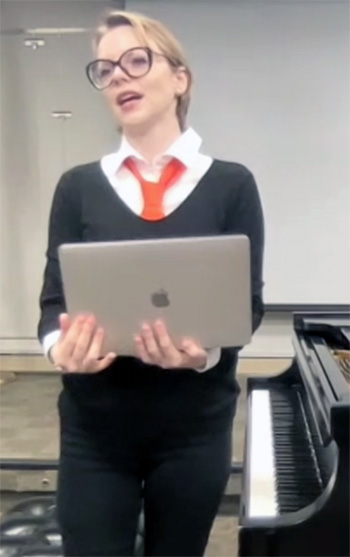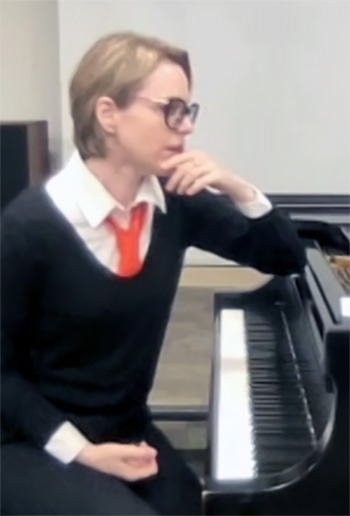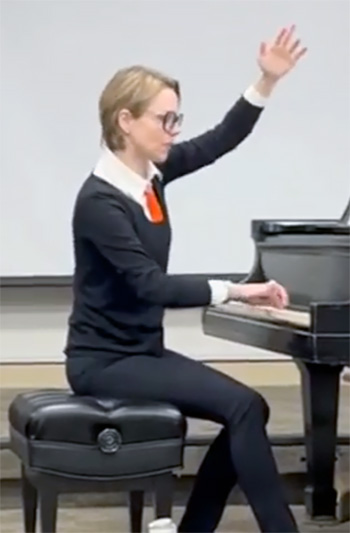Music Educators Association of New Jersey
Serving teachers and students since 1927



International pianist, recording artist, lecturer, teacher and scholar Magdalena Baczewska offered a fresh and insightful presentation on a very old topic to MEA members in the Chase Room and via Zoom. Following announcements made by President Danette Whelan, she was introduced by Ruth Kotik, Ms. Baczewska’s doctoral dissertation was “In Search of Bach’s Cantabile: The Role and Aspects of Oratory and Singing in Keyboard Interpretation.” Holding bachelor and master degrees (Mannes College The New School for Music) and D.M.A. (Manhattan School of Music), she is currently a professor of music and director of the music performance program at Columbia University. For more information see magdalenanyc.com.
 The speaker began with a gracious tribute to the MEA members who have persevered with their teaching during these stressful times. Then she launched enthusiastically into her program. She began by citing the website of Noa Kageyama, at bulletproofmusician.com where one can explore different ways to reduce stress in performance. Yes, help may be found there, but are there guarantees?
The speaker began with a gracious tribute to the MEA members who have persevered with their teaching during these stressful times. Then she launched enthusiastically into her program. She began by citing the website of Noa Kageyama, at bulletproofmusician.com where one can explore different ways to reduce stress in performance. Yes, help may be found there, but are there guarantees?
We seek strategies to improve our memory so that the performer develops confidence. First, there is the aural experience, then the visual, which involves the view of the score and of the hands and keys. Ms. Baczewska described how playing on an unfamiliar keyboard could jeopardize memory. Then there is structural memory, the study of theoretical features. But how much time is there in a lesson to fully explore this aspect? At the piano lesson one may be limited to point out only the most essential features.
How do we memorize a piece? One approach is holistic: to play it through. Another is additive: memorize and add four measure at a time, or segmented: affix letters to the score (A, B, C, ...) and memorize in “chunks.” This segmented method promotes learning the beginnings and endings of each section, creating the emergency exits and continuation points that can add to the performer’s feeling of security. It may increase focus on the closing sections. Finally, consider the serial method, where every memorized performance and all corrections are made from the top. This limited plan may result in unnecessary repetitions of the opening sections.
The main objective in learning music is to “make it a part of you.” Try singing a part, try to reproduce any part of the piece, study it hands separately, study and analyze harmonies.The pianist and lecturer Frederic Chiu recommends that students study the score and then write the score, an old method of learning. Also, “play” the piece in your head.
Ms. Baczewska then discussed the teaching of the minuets in G major and G minor by Christian Petzold from the Anna Magdalena Bach Little Note Book . She also performed the pieces, bringing out their beauty. The Minuet in G Major promotes a good five finger position. Think of these as social dances; organization of the measures matched the choreography; the tempo, like the dance, was lively. In Bach’s time, families engaged dance masters. Discuss many aspects of the piece to enhance the learning process. The melody features antecedent and consequent, or question and answer. Study the subtle differences in repeated phrases; find cadences, see symmetry of measure groupings. Think about the legato of diatonic passages; the phrasing extends across the bar lines. Choices must be made regarding ornamentation; a long note may be a good place to insert an embellishment. Should a chord be solid or rolled? Even in this minuet, a more advanced student can experiment with notes inégales.
The Minuet in G Minor can be performed as the middle section in between its related minuet, forming an ABA arrangement. In teaching this second piece, ask the significance of the direction of the melody and counterpoint, examine the accidentals and discuss their functions, find repeated elements, and study the descending bass line.
Bach’s pedagogy is found in his pieces. Our attention turned to the Little Prelude in C Minor, BWV 1999. Here we will learn by studying the harmony. Consider the tensions that build up in the music with the use of accidentals and pedal tones. Why does the piece begin with C minor chords but end on a G major chord? Perhaps because this prelude is to be paired with a piece in G major. Play it a brisk tempo because of the driving pattern of repeated broken chords. The question of an E flat in the bass of m. 23 was answered by the speaker’s preference to maintain the D pedal tone. ‘The E flat is not characteristic of Bach harmony,” she opined.
 Ms. Baczewska recommended maintaining a supple wrist while moving the right hand in and out of the keys. Avoid pronounced finger articulation. As an accomplished harpsichordist, she commented on fingering and hand position. The harpsichordist will disconnect notes a seventh or octave apart, maintaining a five key hand position, while pianists may extend fingers more. A more advanced student may be asked to use the harmonies in this little prelude as the basis for their own keyboard pattern. Students can be encouraged to experiment with playing on both acoustic and electronic instruments. They might come up with words that match the mood of the piece. They can also think about their pieces as played by orchestral instruments: the cello, the trumpet. It’s all part of making music “their own.”
Ms. Baczewska recommended maintaining a supple wrist while moving the right hand in and out of the keys. Avoid pronounced finger articulation. As an accomplished harpsichordist, she commented on fingering and hand position. The harpsichordist will disconnect notes a seventh or octave apart, maintaining a five key hand position, while pianists may extend fingers more. A more advanced student may be asked to use the harmonies in this little prelude as the basis for their own keyboard pattern. Students can be encouraged to experiment with playing on both acoustic and electronic instruments. They might come up with words that match the mood of the piece. They can also think about their pieces as played by orchestral instruments: the cello, the trumpet. It’s all part of making music “their own.”
The cantabile is implied in Bach’s works. Stepwise movement was often legato, while leaps that outlined chords were often detached. Consider the phrasing or bowing of stringed instruments; leaps can be more difficult to connect. The keyboardist applies these principles.
In the Invention in C Major, BWV 772, study the imitation of the stepwise motif, sequences, augmentation, and texture. They suggest phrasing. Excitement builds when both voices have sixteenth notes. Then, when one voice moves and the other is sustained (mm. 15-18) there is the opportunity to insert ornamentation or even trills. As for trills, the beginner will play note against note, then rhythmically double the speed, but the advanced student will play a “wind-up” trill, beginning slowly and accelerating. Use a metronome, practice on a table or a leg; rotate and transfer the weight from finger to finger. The high Cs in m. 20 are next to the highest key on the harpsichord, and they will sound like “the upper limit” comparable to our piano’s highest keys. On the harpsichord, one may “over hold” keys; on the piano, tasteful use of pedaling is fine. “It’s good to use what the piano can do, “ Ms. Baczewska commented.
In the Invention in F Major, BWV 779, we listened to the “swirls” of sixteenth notes. The sections with long leaps of sixths and sevenths required a newer technique: the rotation of the wrist. The live performances of two inventions following her discussions of them were most appreciated. Everything she discussed made sense as we listened intently.
 The final piece discussed was Sinfonia in F Minor, MWV795. With its sighing motif and chromatically descending bass, it is “serious, almost religious.” The right hand plays two voices while maintaining the somber character. Change fingers on repeated keys in the bass. This sinfonia has a subject and countersubject that interact with the chromatic line. The skip-step pattern expands from a third to a tritone and beyond. Voices pull in different directions. The “bitterness of this” is relieved by the Picardy third in the final cadence. The performance was poignant and moving.
The final piece discussed was Sinfonia in F Minor, MWV795. With its sighing motif and chromatically descending bass, it is “serious, almost religious.” The right hand plays two voices while maintaining the somber character. Change fingers on repeated keys in the bass. This sinfonia has a subject and countersubject that interact with the chromatic line. The skip-step pattern expands from a third to a tritone and beyond. Voices pull in different directions. The “bitterness of this” is relieved by the Picardy third in the final cadence. The performance was poignant and moving.
The artist has many YouTube videos of her performances on both instruments. She has also rendered comparative performances in concerts. She is a virtuoso pianist who has an extensive repertoire.
A short question and answer period followed. President Danette Whelan thanked Magdalena Baczewska for her wonderful presentation.
Bertha Mandel, writer
Beverly Shea, editor
Lisa Gonzalez, screenshots and layout